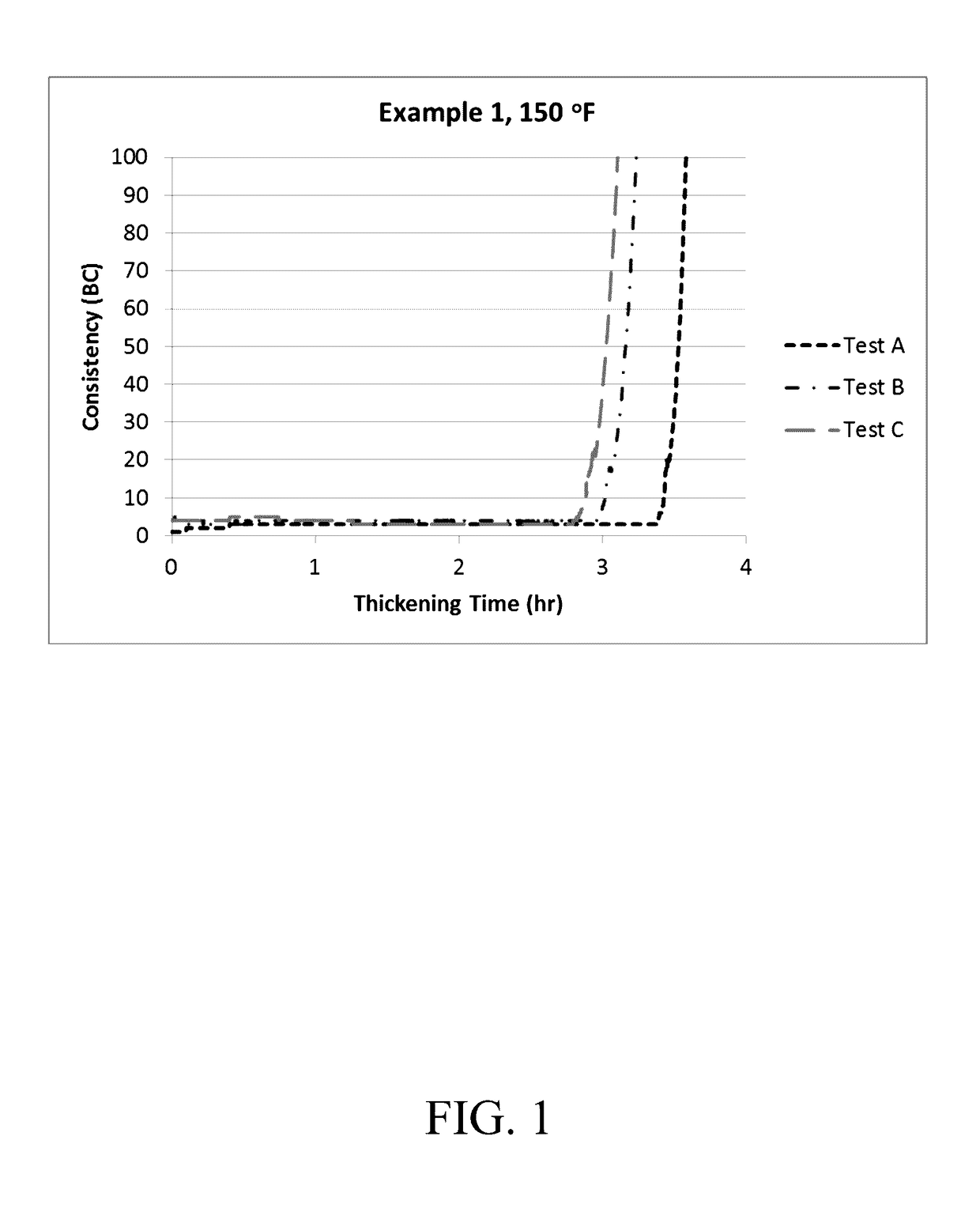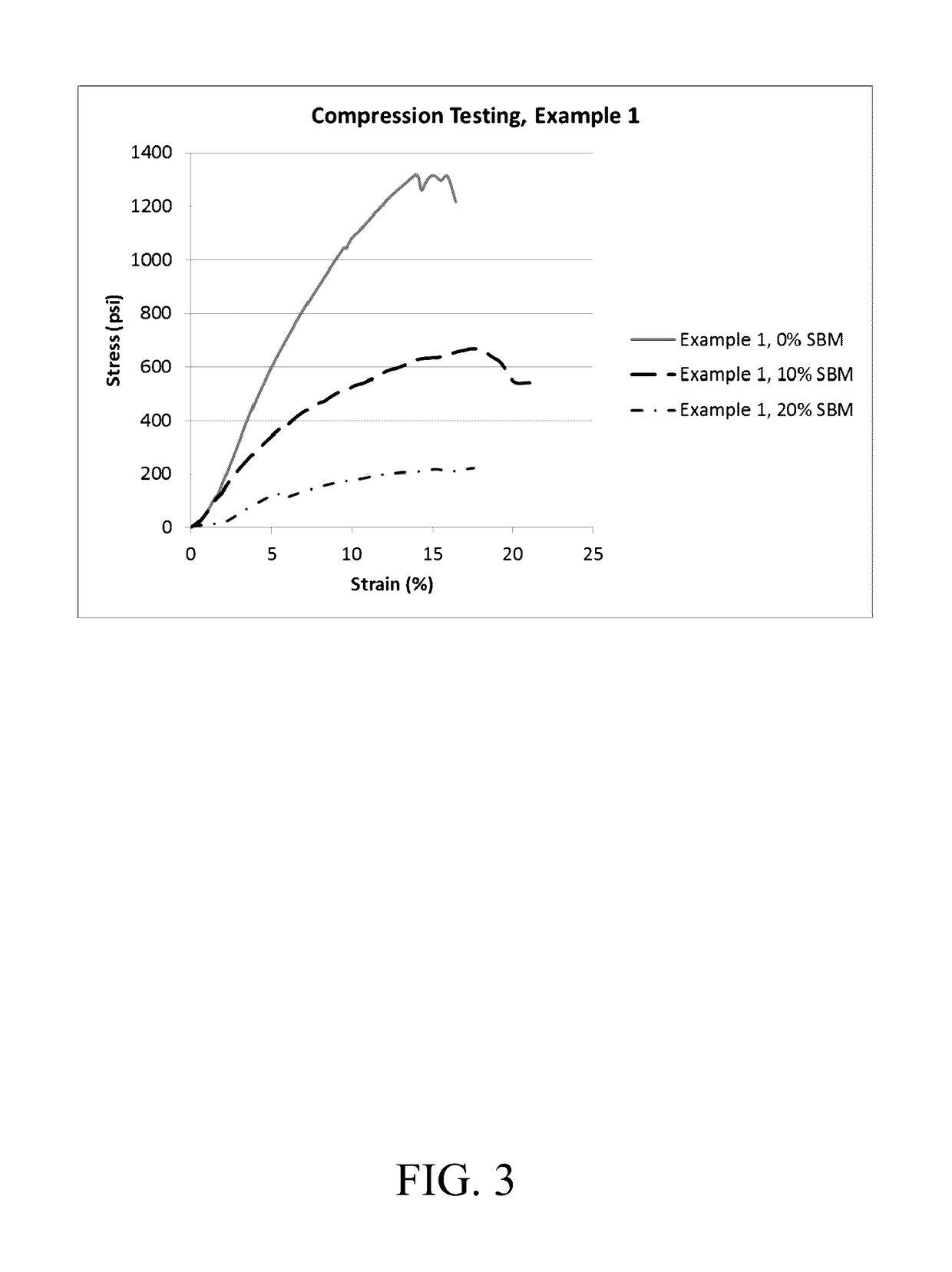Curable, resealable, swellable, reactive sealant composition for zonal isolation and well integrity
a technology of reactive sealant composition and zonal isolation, which is applied in the direction of organic non-macromolecular adhesives, drilling compositions, chemistry apparatuses and processes, etc., can solve the problems of affecting strength, cement may shrink, drilling fluid must gel and thicken quickly,
- Summary
- Abstract
- Description
- Claims
- Application Information
AI Technical Summary
Benefits of technology
Problems solved by technology
Method used
Image
Examples
example 1
Demonstration of Rheology, Thickening Time, and Compressive Strength
[0047]Example 1 was prepared according to the composition given in Table 2. The monofunctional monomer was VeoVa 10; the multifunctional monomer was SR297 (1,3-butyleneglycol dimethacrylate). The reactive polymer was D0243 (SBS); the swellable polymer was FG1901 (MA-SEBS). The sample was then weighted to 12.5 lb / gal with Barimite XF barium sulfate. The purpose of this Example was to demonstrate solution rheology, as well as control over thickening time, and the ability to retain rheology and compressive strength in the presence of oil-based fluid contamination. The fluid used to contaminate the sample was a 12.5 lb / gal Rheliant synthetic-based mud (SBM) obtained from M-I Swaco. Samples of Example 1 were contaminated with 20, 40, 60, and 80 wt. % SBM, wherein the remainder of 80, 60, 40, and 20 wt. %, respectively, of the samples were the composition set forth in Table 2.
[0048]
TABLE 2Example 1 Composition.Component (...
example 2 and example 3
Demonstration of Elasticity, Toughness, and Strength
[0056]Example 2 was prepared according to the present invention and reported in Table 7. The low viscosity monofunctional monomer was VeoVa 10; the multifunctional monomers were SR297 (1,3-butyleneglycol dimethacrylate) and SR833 (tricyclodecane dimethanol dimethacrylate). The reactive polymer was D0243 (SBS); the swellable polymer was FG1901 (MA-SEBS). The sample was then weighted to 14 lb / gal with Barimite XF barium sulfate. The sample was cured with 1.0 phr VulCup 40KE at 93° C. (200° F.) for 24 hours.
[0057]
TABLE 7Ex. 2 Composition.Component2VeoVa 1074.5SR29713SR833S5.0D02436.5FG19011.0VulCup 40KE1.0(phr)
[0058]Example 3 is an example of a 14 ppg cement slurry that may be used in a well with a bottom hole static temperature (BHST) of 25° F.; the composition of this slurry is reported in Table 8. The concentration units used are By Weight of Cement (BWOC), By Weight of Water (BWOW), gallons per sack (gal / sack). The sample was cure...
examples 4-13
Demonstration of Swelling in Oil (Escaid 110 Mineral Oil)
[0061]Examples 4-13 were prepared according to Table 9 below. The monofunctional monomer was VeoVa 10; the multifunctional monomers were SR297 (1,3-butyleneglycol dimethacrylate) and SR833 (tricyclodecane dimethanol dimethacrylate). The reactive polymer was either D0243 (SBS) or AMS 777 (I-SEBS-I); the swellable polymer was either G1654 (SEBS), G1726 (SEBS) or AMS 777 (I-SEBS-I). Once mixed, a small amount of unweighted fluid was set aside; the remaining solution was weighted to 12.5 lb / gal with Barimite XF barium sulfate. To both the unweighted and the weighted solutions was added 0.75 phr (parts per hundred rubber) Luperox ACP35, where “rubber” is the reactive sealant composition. Duplicates of each sample were cured at 150° F.). (65° for 24 hours under 300 psi N2 to be tested for swellability in oil and for storage modulus via Dynamic Mechanical Analysis (DMA). For the swelling test, each sample was cut into three pieces; f...
PUM
| Property | Measurement | Unit |
|---|---|---|
| wt. % | aaaaa | aaaaa |
| wt. % | aaaaa | aaaaa |
| compressive strength | aaaaa | aaaaa |
Abstract
Description
Claims
Application Information
 Login to View More
Login to View More - R&D
- Intellectual Property
- Life Sciences
- Materials
- Tech Scout
- Unparalleled Data Quality
- Higher Quality Content
- 60% Fewer Hallucinations
Browse by: Latest US Patents, China's latest patents, Technical Efficacy Thesaurus, Application Domain, Technology Topic, Popular Technical Reports.
© 2025 PatSnap. All rights reserved.Legal|Privacy policy|Modern Slavery Act Transparency Statement|Sitemap|About US| Contact US: help@patsnap.com



